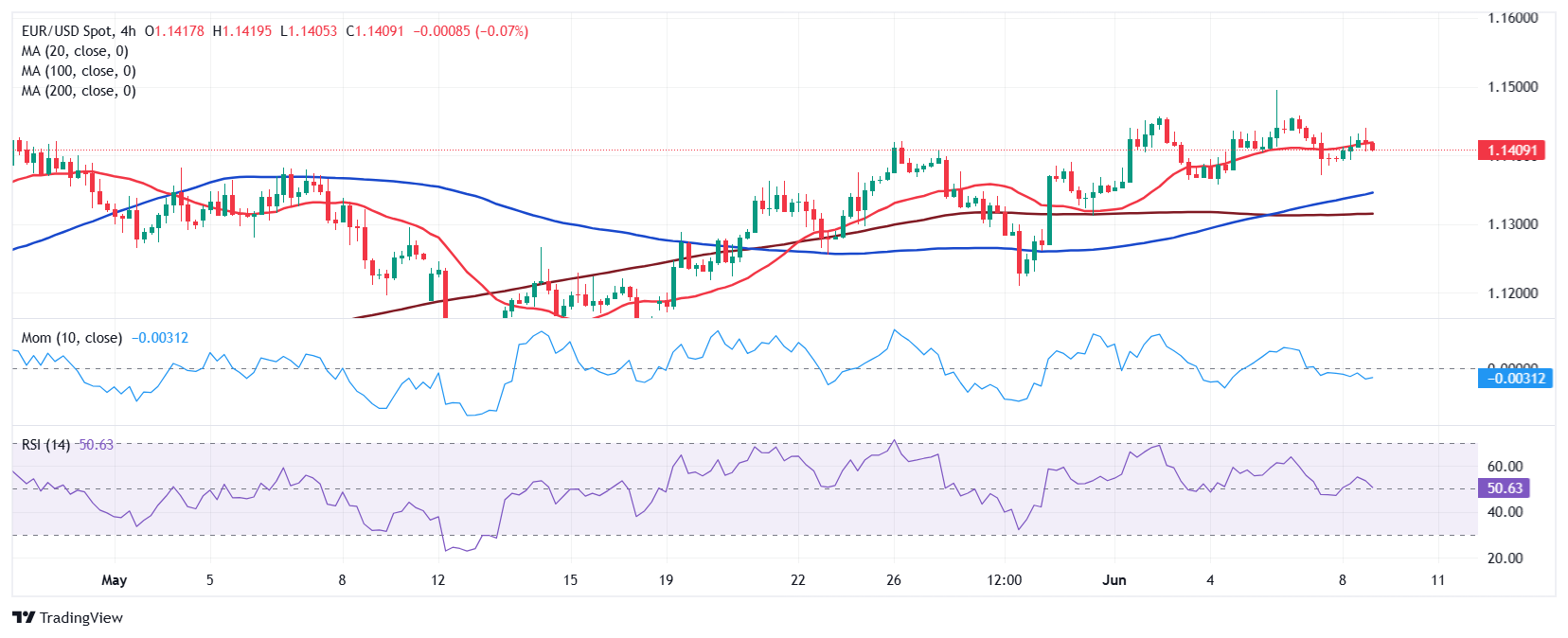
EUR/USD Current price: 1.1408
- Most European markets are closed due to the celebration of Whit Monday.
- The US macroeconomic calendar will remain scarce until Wednesday.
- EUR/USD could extend its near-term retracement below the 1.1400 mark.

The EUR/USD pair trades above the 1.1400 mark on Monday, trimming half of Friday’s losses inspired by a better-than-anticipated United States (US) May Nonfarm Payrolls report. The country added 139K new job positions, better than the 130K anticipated, while the Unemployment Rate held steady at 4.2% as expected. The US Dollar (USD) appreciated with the headlines, also helped by profit-taking ahead of the weekly close.
The macroeconomic calendar has little to offer amid most European markets closed due to Whit Monday. Nevertheless, market players have something to care about: Top US and Chinese representatives will resume trade talks in London. Following an initial agreement in Geneva early in May, hopes cooled amid Washington and Beijing reciprocally accusing from breaching the deal. Tensions arose until last Thursday, when US President Donald Trump and Chinese leader Xi Jinping had an extensive trade call in which they agreed to today’s meeting.
Other than that, the macroeconomic calendar remains scarce as most European markets are closed due to the celebration of Whit Monday. The American session will not bring anything relevant, with the calendar becoming more interesting on Wednesday, when the US will release May Consumer Price Index (CPI) figures.
EUR/USD short-term technical outlook
The daily chart for the EUR/USD pair shows it trades at the lower end of its Friday range, retreating from an early peak at 1.1439. The pair keeps developing above all its moving averages, with the 20 Simple Moving Average (SMA) gaining upward traction and providing dynamic support at around 1.1310. Technical indicators, in the meantime, remain well above their midlines, although lacking clear directional strength, maintaining the risk skewed to the upside. Finally, the 100 SMA advances beyond the 200 SMA far below the current level, in line with the dominant bullish trend.
In the near term, and according to the 4-hour chart, EUR/USD is neutral, with an increased risk of piercing the 1.1400 mark. The pair is extending its slide below a now flat 20 SMA, while holding above the longer ones. Technical indicators, in the meantime, turned lower at around their midlines, anticipating a potential drop towards the 1.1380 region. Steeper declines are unlikely unless impressive US-China trade talks.
Support levels: 1.1385 1.1340 1.1310
Resistance levels: 1.1435 1.1470 1.1505
Tariffs FAQs
Tariffs are customs duties levied on certain merchandise imports or a category of products. Tariffs are designed to help local producers and manufacturers be more competitive in the market by providing a price advantage over similar goods that can be imported. Tariffs are widely used as tools of protectionism, along with trade barriers and import quotas.
Although tariffs and taxes both generate government revenue to fund public goods and services, they have several distinctions. Tariffs are prepaid at the port of entry, while taxes are paid at the time of purchase. Taxes are imposed on individual taxpayers and businesses, while tariffs are paid by importers.
There are two schools of thought among economists regarding the usage of tariffs. While some argue that tariffs are necessary to protect domestic industries and address trade imbalances, others see them as a harmful tool that could potentially drive prices higher over the long term and lead to a damaging trade war by encouraging tit-for-tat tariffs.
During the run-up to the presidential election in November 2024, Donald Trump made it clear that he intends to use tariffs to support the US economy and American producers. In 2024, Mexico, China and Canada accounted for 42% of total US imports. In this period, Mexico stood out as the top exporter with $466.6 billion, according to the US Census Bureau. Hence, Trump wants to focus on these three nations when imposing tariffs. He also plans to use the revenue generated through tariffs to lower personal income taxes.
Information on these pages contains forward-looking statements that involve risks and uncertainties. Markets and instruments profiled on this page are for informational purposes only and should not in any way come across as a recommendation to buy or sell in these assets. You should do your own thorough research before making any investment decisions. FXStreet does not in any way guarantee that this information is free from mistakes, errors, or material misstatements. It also does not guarantee that this information is of a timely nature. Investing in Open Markets involves a great deal of risk, including the loss of all or a portion of your investment, as well as emotional distress. All risks, losses and costs associated with investing, including total loss of principal, are your responsibility. The views and opinions expressed in this article are those of the authors and do not necessarily reflect the official policy or position of FXStreet nor its advertisers. The author will not be held responsible for information that is found at the end of links posted on this page.
If not otherwise explicitly mentioned in the body of the article, at the time of writing, the author has no position in any stock mentioned in this article and no business relationship with any company mentioned. The author has not received compensation for writing this article, other than from FXStreet.
FXStreet and the author do not provide personalized recommendations. The author makes no representations as to the accuracy, completeness, or suitability of this information. FXStreet and the author will not be liable for any errors, omissions or any losses, injuries or damages arising from this information and its display or use. Errors and omissions excepted.
The author and FXStreet are not registered investment advisors and nothing in this article is intended to be investment advice.







